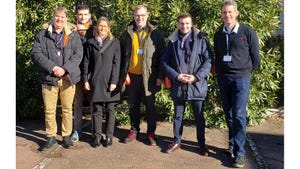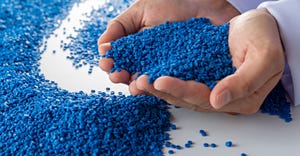IMM's Plant Tour: Modeling to molding mastery
December 30, 1999
Prototype to production is one of the most 'beat' expressions in the industry," says Bob Bechtold, a 23-year molding and moldmaking veteran and president of Harbec Plastics, Ontario, NY. "But, here it's not a marketing term, it's what we really do." Begun as a contract tool and die shop, Harbec was established in 1977, and has blossomed into a precision custom molder, moldmaker, and model shop specializing in high-end, exotic materials, thick-walled precision parts, and insert molding.
By controlling more of the steps in the production of molded parts, Bechtold believes Harbec has built-in assurance that the molding process is as efficient and cost-effective as possible. "Combined efforts of the engineering, modeling, tooling, and molding departments allow us to tackle complex parts," he says.
Prototypes and Tools
Our tour begins at the model shop, which produces all of the engineering prototypes for Harbec's customers. An engineering model differs from a concept prototype in that it contains properties as close to those of the production part as possible. According to general manager Jack Schultz, the shop delivers functional, dimensionally accurate prototypes in about two weeks.
Fifteen employees staff the modelmaking area, which consists of a CAM room, CNC machines, and a machining center. In addition to this equipment, Bechtold plans to add a 110-ton press to run rapid tools for prototypes.
Modelmakers program their own NC toolpaths in Mastercam. Many prototypes are CNC machined from the same material and to the same tolerances as the production part. Models are also produced via silicone rubber molding or a Sanders RP system with tolerances of ±.001 inch (x and y), and ±.0005 inch (z).
Rather than dictating what kind of rapid prototype a customer needs, Harbec has invested in several different methods. "After years of experience and participating in tests, we've found that there is no one answer for all applications," Bechtold says. "We recently introduced a service called QMS [quick manufacturing solutions] that lets us choose the best process for a customer's project based on the part itself and what the priorities are-accuracy or speed, for example." Choices include not only those just mentioned, but also parts made from a variety of different rapid tools-electroformed, polymeric steel, polymeric aluminum, and sintered metal.
Toolmakers and modelmakers move freely between this area and the toolmaking room, utilizing any of the 23 machines shared between the two departments. "They don't see the equipment as proprietary," says Schultz, "because we have eliminated the psychological walls. A project may start at the modeling department, and as the part evolves, the information flows between all of our disciplines. When we build a prototype or production tool, for example, the experience of the combined enterprise is available to everyone."
About 90 percent of the tools Harbec runs are built in-house by a staff of experienced moldmakers. They program toolpaths in a second CAM room located in the mold shop, which also includes one wire and four sinker EDM machines, as well as CNC machining centers and grinders.
Moldmakers work together with the engineering department to review designs for moldability, simplification, and critical areas. If a feature will be difficult to fill, for example, the mold designer and toolmaker may opt for adding an insert or modifying the feature. All of this is done while in contact with the customer.
Bechtold believes this integration under one roof is key to molding efficiency and success. "Each project starts with a design review meeting, which is attended by all disciplines. Getting input from our customers, designers, process engineers, and toolmakers at that early stage helps us improve productivity every step of the way." Harbec installs a Web broadcast system at the customer's site to conduct this real-time collaboration.
Shop-floor Dynamics
The only way to describe the plant floor is electrified. Today, more than 70 percent of the presses are all-electric injection molding machines, and that figure may change to 100 percent by next year, according to Bechtold. Three years ago Harbec made the switch to all-electrics and was won over. "The higher initial cost of the presses is offset by their power efficiency," he says. "We use up to 50 percent less electricity and generate 50 percent less heat. As a bonus, the machines are quieter and we don't have to deal with oil leaks."
A quintet of 55-ton Roboshot all-electrics are dedicated to running small, precision parts at high speeds. A single car piston seal being produced during the tour was running on 5-second cycles using PEEK material. The tool contains a slide and cam pin, and requires 400F oil heating to maintain mold temperatures. In another Roboshot, Harbec molds PEEK isolator sleeves in an eight-cavity tool, this time oil-heated to 270F.
"With high-tolerance parts, it is especially important to keep temperatures constant. High yields are the holy grail for these applications, and by using closed loop controls and monitoring the process parameters, we're able to achieve that," Bechtold adds. Each of the Roboshots is equipped with a Fanuc Act controller.
Larger tonnage presses (165 to 440 tons) line the other side of the molding bay. Jobs in progress included a diesel forward filter canister with a threaded screw insert being molded on a 220-ton Powerline (Elektra), the first such machine Milacron built. The canisters are molded from clear ETPU (Isoplast 302EZ, Dow) for customer Davco Mfg., a supplier to heavy truck OEMs.
Doug McKnight, process engineer, explains that after some trial and error, Harbec found that drying was critical to the ETPU material. "The material flows well, but without drying, there are problems with flow lines, splay, and jetting," says McKnight. "We keep the barrel temperature high for a uniform melt [480F] and use a large gate for easy flow. In addition, the tool must be well-vented."
Internal parts for file cabinets are molded on a 440-ton hydraulic press. Using a two-cavity mold, Harbec produces both letter and legal size versions of the HDPE part in a single shot. Yet another press is busy turning out nylon automotive tensioner faces for Borg-Warner at the rate of 125,000/week. "Weekly maintenance on this tool is a must," McKnight adds.
Project Success
Seeing a molding project through from inception instills a sense of pride, evident when Bechtold displays his trophy shelves lined with prototypes and their respective production parts. "We look for metal parts to convert to plastic because those are the tough applications that we do best."
A thick-walled pump part, for example, was converted to plastic using an insert molding solution that saved secondary assembly and the need for seals. Printer carriages were also converted using a conductive resin to dissipate static. This project was also insert molded and eliminated the need for secondary machining.
A current job running at Harbec had its roots in the model shop when customer Borg-Warner was having trouble testing the plastic tensioner faces that would mount onto a metal arm. "They were using aluminum sand castings to model the tensioner arm, but these weren't strong enough to withstand testing," recalls Bechtold. "We carved them out of aluminum to the same tolerances as the diecast production models would need, and then added our prototype tensioner faces so that they could run tests."
At other times, customers need design assistance. Bechtold recalls a project with Towmotor in which the company brought in Renboard versions of an ergonomically correct handle for a new product that would contain only two hand grips. "We digitized the Renboard models, created CAD data, added wire paths, and switched the openings so that the handle could be used on both grips. After cutting the prototype tool, we had a 15-minute debug before the first shot, which was good."
Recently, Harbec worked with a sporting goods manufacturer that wanted to bring a new inline skate to market. The skates, developed exclusively for professional indoor hockey leagues, were based on a thick, plastic frame. The OEM had been frustrated by other materials' lack of structural strength, and turned to Harbec for alternatives. "Our designers suggested glass-filled Isoplast, which withstood the loads and met weight requirements," Bechtold says. "We also helped to design the frame, which weighs more than a pound."
Molding the Environment
Take a look at Harbec Plastics' logo, and you'll notice a tag line under the name. It says "Technical Innovation With Environmental Responsibility." More than just a buzzword, the environment is a major concern here. President Bob Bechtold believes that being environmentally conscious benefits everyone, including molders and their customers.
Harbec has embarked on becoming ISO 14000-certified-the environmental standard. Currently compliant, the company hopes to be certified by July 2000. In addition, a future expansion is planned as a "zero energy" project. That means the building uses as little traditional energy as possible. According to Bechtold, the new facilities will include the following:
Composite panels and roofing.
Skylights and glass panels.
Heavy insulation.
Solar photovoltaic cells for power generation.
A wind hybrid power system (a 225-kW wind generator supported by natural gas microturbines that use absorptive chilling to capture heat from ambient air and use it to heat and cool the building).
When the dust settles, Bechtold believes he can reduce the cost of energy from 10¢/kWh to 6.5¢/kWh and reflect the savings back to his customers. The project, which has been in development for 61/2 years, is a tough one to sell to bankers, but it's based on proven and repeatable technology.
You May Also Like


